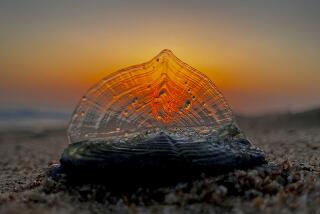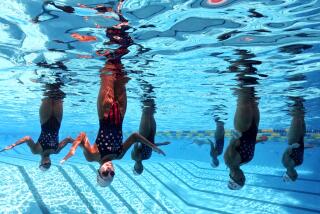In swimming, jellyfish and lampreys really pull their weight
- Share via
Other than living in water, the bulbous jellyfish and the sinuous lamprey may seem to have little in common. And yet these two animals share a remarkable ability that allows them to move with great efficiency — they essentially pull, rather than push, their way through the water.
Instead of creating high-pressure zones by pushing against the water, these two very different animals actually generate areas of low pressure that force water past their bodies, according to new research out of Stanford University and the Marine Biological Laboratory in Woods Hole, Mass.
The discovery, published this week in the journal Nature Communications, may force scientists to rethink some of the most fundamental assumptions about animal propulsion — and help inform the future design of bioinspired swimming robots.
The findings “have opened our eyes to a whole lot of possibilities,” said senior author John Dabiri, a fluid dynamicist at Stanford University.
Many researchers had figured there would be shared principles underlying all forms of natural locomotion, whether through air, water or even on land.
Animals generally move on land by pushing against surfaces to propel their bodies forward, thus generating an area of high pressure between their feet and the ground. Humans swim this way, too, using our arms and legs to push against the water, generating high-pressure regions in the places where we push it out of the way.
It’s long been thought that this is essentially how the ocean’s more gifted swimmers move: A fish might swing its tail back and forth, pushing against the water. It seems to make intuitive sense.
But Dabiri began to suspect that something else was going on in certain highly efficient swimmers. His doubts emerged while he was studying the wakes of jellyfish a few years ago.
So he and his colleagues took a fresh look at jellyfish and their undulating, bell-like profiles. They also studied lampreys, jawless fish with long, snaky bodies. These two animals may look vastly different, but they share a common distinction: They’re both among the ocean’s most efficient swimmers.
The scientists outfitted a water tank with lasers and cameras and added millions of tiny silver-coated glass beads just 10 micrometers across. As the animals swam through the water, the lasers highlighted the movement of the glass beads — a technique called particle image velocimetry.
“The images almost look like a starry night — except in this case, those stars move along with the water,” Dabiri said.
The researchers sent jellyfish and lampreys swimming back and forth in the tank and watched how the water moved. For the lampreys, the scientists studied two fish that swam normally and two that had been modified so they could use only their tail ends to swim, instead of their entire bodies.
Tracking these beads through the water is great for determining the movement of the water, but it’s more difficult to use that information to calculate water pressure.
Using an 18th-century formula devised by Swiss mathematician Leonhard Euler and a sophisticated computer algorithm to crunch the numbers, the scientists were able to use the flow measurements to map out the water pressure around the animals’ bodies.
The researchers found that the jellyfish and normal lampreys were bending their bodies in a way that created low-pressure zones at the curves, causing water ahead of them to rush in and fill those zones.
By creating these low-pressure areas, the animals essentially were sucking their bodies forward through the water.
And while there were high-pressure zones created in this process, Dabiri’s team found that those zones were essentially the byproduct of the animal’s motion, not the reason for it.
The lampreys that could use only their tail ends couldn’t generate the same low-pressure zones, so they had to swim by pushing against the water, as scientists initially expected. But this swimming method was far less effective; the lampreys were 40% slower than their counterparts who could generate the low-pressure zones.
“The animals are pulling the water ahead of them backward, and so it’s the difference between using ropes to move around versus something stiff that you can push against,” Dabiri said. “It was very non-intuitive, so we spent the past couple years trying to convince ourselves that we weren’t fooling ourselves.”
This approach appears best for high-efficiency swimming — the type of motion that might not be speedy but that doesn’t waste energy, Dabiri added. To escape a predator, certain swimmers might still push against the water to get away fast.
The findings could compel evolutionary biologists to rethink why certain body plans and swimming behaviors have evolved over time. And it could help researchers design underwater robots that could roam the oceans for long periods of time without needing a recharge — vehicles that could take scientific measurements to monitor the environment or perhaps scan the seas for underwater mines.
Follow @aminawrite for more fascinating science news from the animal kingdom.







